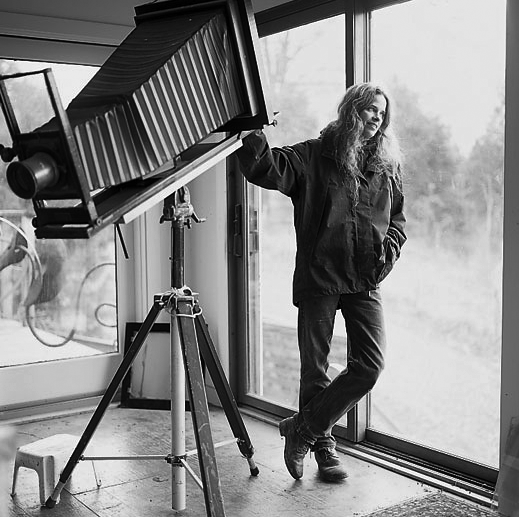Welcome to Pho·tog Friday!
Born in Lexington, Virginia, Sally Mann is a contemporary photographer who is well known for her portraits, landscapes and still life images. As you can see in the picture below, Mann shoots her images with a 8x10 Bellows View Camera, which is roughly one hundred years old. The camera certainly does not take an SD Card nor does it take a roll of film. Mann's images are created on a glass plate using the wet collodion process.
Mann has been active in the art world since the late '60s when she began studying photography at The Putney School. She earned her BA from Hollins College in 1974 and began working as a photographer at Washington & Lee University, where she photographed the construction of Lewis Hall. These images were displayed at the Corcoran Gallery of Art in Washington D.C. for her first solo exhibition in 1977. The second body of work that Mann displayed to the public in 1988 was titled At Twelve: Portraits of Young Women. According to The Museum of Contemporary Photography, this series "captured the confusing emotion and developing identities of adolescent girls (and the) expressive printing style lent a dramatic brooding mood to all of her images":
 |
| Mann, Sally, At Twelve: Portraits of Young Women, 1983-1985. |
Mann saw her subjects as being "vulnerable in their youthfulness" although still having a sense of strength. In the last image, the subject is seen posing with her mother's boyfriend. Mann did not intend to crop her left elbow although the young lady refused to stand any closer to him. Months after this photograph was taken, the mother shot her boyfriend in the face with a .22 and claimed during the court hearing that her boyfriend had been sexually harassing her daughter.
Mann is best known for the portraits which she published in a book titled, Immediate Family. There are sixty-five images within the series and all were taken of her own three children under the age of ten. The majority of these photographs were taken at their remote family cottage in Southern Virginia. Within the photographs, you can see her children exploring some of the "lighter" themes that occur throughout childhood: playing board games and dress up, napping, and reading the comics. In other photographs, the themes are a bit more "darker" and touch on loneliness, sexuality and death:
 |
| Mann, Sally, Immediate Family, 1984 - 1991. |
 |
| Mann, Sally, Immediate Family, 1984 - 1991. |
 |
| Mann, Sally, Immediate Family, 1984 - 1991. |
 |
| Mann, Sally, Immediate Family, 1984 - 1991. |
Naturally, nude photographs of children caused "a stir" when the book was released in 1992. Mann's images produced an ethical debate about if children should be photographed naked, particularly for profit. Mann considered the images of her kids to be normal given the fact that she also grew up in a house where she and her siblings roamed around without clothes on as kids.
What many displeased viewers do not know - or simply do not care to find out - is that Mann's family voted on the publication of this book together. Each child had a say in which images of themselves were permitted into the book and in attempts to make sure her children were mentally sound regarding the book, Mann had them speak to a child psychiatrist. Mann herself was unsure about how the public would react to the photos and in turn, spoke with a lawyer. Mann's attorney did inform her that some of the images within the Immediate Family series could get her arrested although she proceeded with the publication regardless.
 |
| Mann, Sally, Fallen Child from the Immediate Family Series, 1984 - 1991. |
Aside from the controversy behind this series, one cannot deny the almost fantasy like world Mann has created in these photos of her kids. Mann's unique use of light within the images draws her viewer's eyes directly to her subjects within the frame. Their childhood seems to be from another time or place. When you hear her children speak about the images today as adults, it is quite clear that they all participated willingly for their mother's artwork. In 2001, Time named Mann as "America's Best Photographer" and stated,
"Mann recorded a combination of spontaneous and carefully arranged moments of childhood repose and revealingly - sometimes unnervingly - imaginative play. What the outraged critics of her child nudes failed to grant was the patent devotion involved throughout the project and the delighted complicity of her son and daughters in so many of the solemn or playful events. No other collection of family portraits is remotely like it, in both its naked candor and the fervor of its maternal curiosity and care" (Price, Web).
Sally Mann was featured in an episode of Art21, which is a television show on PBS. Within this episode, you can hear Mann discuss her own work and progress. Check out the trailer for the episode in the video below:
To watch the entire episode, please click "here". As her children got older, she continued to photograph them although thought that her images were starting to appear similar to fashion advertisements. Mann then began photographing something a little different... stay tuned for Part II of this Pho·tog Friday Series on Sally Mann!
____________________________________________________________________________
01. "Sally Mann." Sally Mann. N.p., n.d. Web. 18 Oct. 2013.
02. "Sally Mann." Art21. PBS, n.d. Web. 18 Oct. 2013.
03. "Sally Mann | Art21 | Preview from Season 1 of "Art in the Twenty-First Century" (2001)." YouTube. YouTube, 14 Dec. 2007. Web. 18 Oct. 2013.
04."Sally Mann." Wikipedia. Wikimedia Foundation, 16 Oct. 2013. Web. 18 Oct. 2013.
05. "Photographer: Sally Mann." TIME.com. N.p., n.d. Web. 18 Oct. 2013.
06. "Sally Mann." Museum of Contemporary Photography. N.p., n.d. Web. 18 Oct. 2013.






